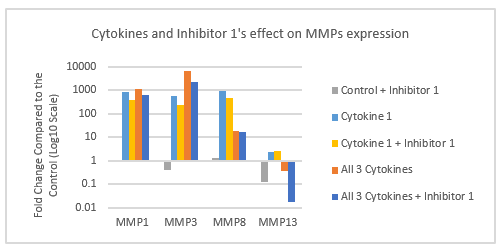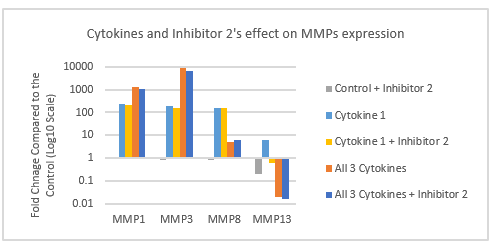ACT summer studentship: Determining if NFκB inhibitors can prevent the negative effects of a combination of inflammatory cytokines on adult tendon cell gene expression
Anna Lexin Zhou (BVetMed1 student) was awarded an Animal Care Trust summer studentship for the summer of 2021. She worked with Dr Debbie Guest on the following project: Determining if NFκB inhibitors can prevent the negative effects of a combination of inflammatory cytokines on adult tendon cell gene expression.
Anna found the experience very beneficial: "The REP has given me a very special first-time experience in research work, I am very grateful for this opportunity and everyone who I worked with, I have always been supported and trusted by the team during my placement. I have learnt a lot about the NF-κB pathway, about how research is generally planned and progressed, and I have gained many practical skills, in a very short amount of time".
Aims of the project:
Previous research (McClellan et al., 2019) in combine with current ongoing research data, have shown that inflammatory cytokines: IL-1β, TNFα and IFNγ are also responsible for the change in tendon-gene expression, and the decrease in contractability in horses’ adult tendon cells. IL-1β, and TNFα are known to work through stimulating NF-κB canonical pathway (Lawrence, 2009). In comparison, IFNγ signal to change gene expression via JAK–STAT pathway, and has no effect on NF-κB pathway (Crow et al., 2013, Vilček and Le, 1998). For this project, NF-κB Inhibitors were investigated for their ability to block cytokines led NF-κB activation; and ultimately their ability to prevent change in gene expression in horses’ adult tendon cells is investigated. Objective one: determine the minimum dose of the inhibitors required to block IL-1β and TNFα led NF-κB P65 translocation into the nucleus of horse adult tendon cells. Objective two: determine maximum dose of the inhibitors can be used without changing adult tendon cell morphology significantly. Objective three: determine the maximum dose of inhibitor can be used without decreasing adult tendon cell viability significantly. Objective four: determine the most suitable dose for each inhibitor by comprising between their inhibitory ability and healthiness of the cells. Objective five: investigate inhibitors’ ability in preventing IL-1β, TNFα and IFNγ led gene expression change.
Outcomes
Fluorescent images from immunocytochemistry staining NF-κB P65 have shown all four inhibitors were able to block cytokine (IL-1β and TNFα) stimulated P65 translocation into the nucleus to some extent; indicating that all inhibitors are able to prevent cytokine stimulated NF-κB activation at different minimum doses.


Phalloidin immunocytochemistry images compares the actin of cytokines and inhibitors stimulated tendon cells and unstimulated tendon cells; results have suggested that the different inhibitors each had different maximum doses that can be used to stimulate adult tendon cells for 72 hours, without causing significant amount of change in cell morphology.


Presto blue assay results are statistically analysed using SPSS, and results have shown maximum doses of the four inhibitors when used to stimulate adult tendon cells for 72 hours, without significantly decrease the cell viability.
These results were used to select one dose for each inhibitor to stimulate adult tendon cells for qPCR. Inhibitors at chosen dose did not cause obvious effect on tendon genes’ expression, however, seem to have some effect on MMPs expression in cytokine stimulated adult tendon cells: Inhibitors 1 and 3 seem to be able to prevent MMP 13 expression increase, and inhibitor 4 seems to inhibit all MMP 1, 3, 8, and 13 expression increase; however, inhibitor 1 could not block effect of IL-1β alone on MMP 13, and although inhibitor 1 and 3 has led to further decrease, all three cytokines together did not initially increase MMP 13 expression in adult tendon cells, hence the inhibitors’ role in preventing the cytokines led expression increase could not be confirmed. Whereas for inhibitor 4 which seems to block some of the cytokines led expression increase on all the chosen MMPs, the inhibition was not able to bring their expression down to control level. In conclusion, the qPCRs result show that either the inhibitors at chosen dose have a slight effect on tendon genes and MMPs expression which have to be proven with more replications, or the chosen doses were too weak to inhibit cytokines’ effect.


With only one replicate for each inhibitor has been done, it is hard to carry out any valid statistical analysis or to confirm any significant effect of the inhibitors on gene expression. More qPCRs using different doses of the inhibitors, or qPCRs targeting different tendon genes might need to be done to further investigate the ability of the inhibitors in preventing cytokines caused tendon gene expression change. Otherwise, 3D gels can be set up using cells stimulated by both cytokines and inhibitors, to investigate if inhibitors could prevent the decrease in tendon cell contractability. As ultimately, by preventing inflammatory cytokines: IL-1β, IFNγ and TNFα causing negative effects on gene expression and adult tendon cell contractibility while maintaining their normal function in inflammatory pathways, it might be possible to converse the healthy mechanical properties in post-injury tendon tissue, hence lead to a better heal and reduce chances of reinjury.
Anna concluded her REP experience by advising "My experience at the REP definitely have showed me another possibility for my future career, I’ve become much more confident in and more open about doing something similar in the future".
Citations:
CROW, M. K., NIEWOLD, T. B. & KIROU, K. A. 2013. Chapter 7 - Cytokines and Interferons in Lupus. In: WALLACE, D. J. & HAHN, B. H. (eds.) Dubois' Lupus Erythematosus and Related Syndromes (Eighth Edition). Philadelphia: W.B. Saunders.
LAWRENCE, T. 2009. The nuclear factor NF-kappaB pathway in inflammation. Cold Spring Harb Perspect Biol, 1, a001651.
MCCLELLAN, A., EVANS, R., SZE, C., KAN, S., PATERSON, Y. & GUEST, D. 2019. A novel mechanism for the protection of embryonic stem cell derived tenocytes from inflammatory cytokine interleukin 1 beta. Sci Rep, 9, 2755.
VILČEK, J. & LE, J. 1998. Interferon γ. In: DELVES, P. J. (ed.) Encyclopedia of Immunology (Second Edition). Oxford: Elsevier.
